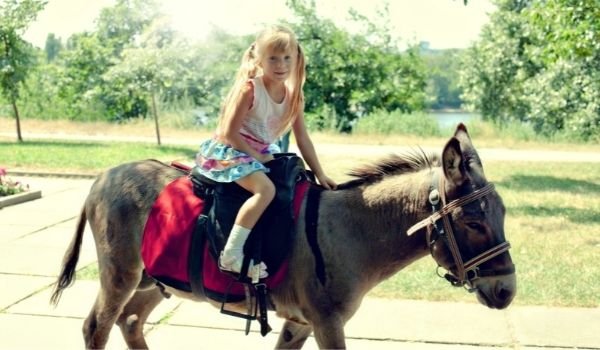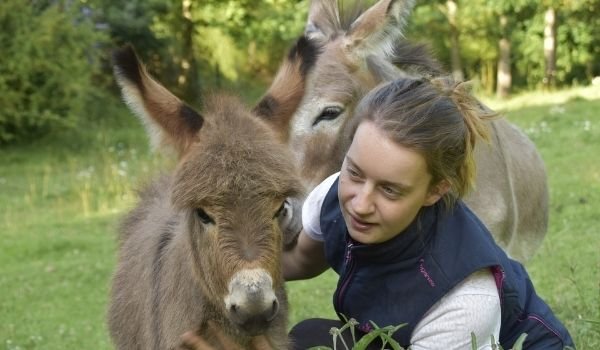Donkeys have been used for carrying loads since ancient times. It is this animal on whose weight-carrying capacity the earlier economies prospered: Egyptians exported their precious metal outside Africa by carrying it on donkeys, Silk Roads were made possible because of the silk-carrying donkeys, Ancient Romans used them to transport agricultural products, and much more that continues even today in many parts of the world.
Looking at such a plethora of examples, it is easy to deduce that donkeys can carry human beings too. Can you ride donkeys? Yes, you can – but that is not all. For the sake of the well-being of your donkey, read the details below on what is recommended and what you should avoid while riding it.
Can You Ride Donkeys?
Absolutely, it is perfectly fine for you to ride donkeys; however, there is a caveat attached: just as in the case of the weight carrying capacity of horses, donkeys cannot carry more than 20 to 30% of their own weight.
Considering a fully grown and healthy donkey’s average weight to be up to 1,000 pounds, adult donkeys can carry you safely, provided your mass is no more than 200 to 300 pounds. Also, note that this figure does not include the weight of tack and other accessories. If these items are to be included, you need to get rid of some more fat to fit into this range. Nevertheless, in most cases, donkeys deem to be perfectly okay to be ridden by children.
Donkeys Can Pull More Than They Carry!
Donkeys are a lot stronger than they look and can pull the load twice their weight. Thus, an average donkey can pull up to 1,600 pounds.
Role of a Donkey’s Age
In contrast to horses, donkeys have a longer lifespan: where horses have an average lifespan of about 25 to 30 years, donkeys have an average life span of 27 to 40 years and can even live up to 50 years. Owing to this fact, donkeys also mature comparatively slowly. Therefore, while most horse breeds can be ridden when they are aged between two to three, donkeys need to attain the age of at least five years before they are able to carry a person without any health hazard. However, without a rider, there is no harm in starting training your donkey at the age of four years.
Donkey Rider Weight Chart: Role of a Donkey’s Type
Note that there are three types of donkeys according to size: miniature, standard, and mammoth. Each type has a different weight and based on the 20 – 30% rule, the miniatures are best suited for children, while the mammoths are capable of carrying overweight people.
The following donkey rider weight chart will clarify the point further:
| Type of Donkeys | Height of the Donkey | Weight of the Donkey | Maximum Weight Carrying Capability |
| Miniature | 6 to 9 hh | 200 to 400 lbs. | 60 to 120 lbs. |
| Standard | 9 to 14 hh | 400 to 900 lbs. | 120 to 270 lbs. |
| Mammoth | Above 14 hh | 900 to 1,300 lbs. | 270 to 350 lbs. |
Role of a Donkey’s Health
A donkey in a good state of health may be able to bear the load up to its full potential compared to the one that is not. Besides, those donkeys, which stay physically active or are ridden, often may handle weight far better than those pampered as pets.
Here is a checklist to confirm that your donkey is healthy to be ridden.
- Is it nourished well?
- Is it breathing normally?
- Is it in good physical shape?
- Are its hooves okay?
- Is its balancing ability good?
Do Donkeys Like Giving Rides?
If trained properly, donkeys do not mind giving rides. Though they might not enjoy doing so, the same way horses do, being ridden is not an offense for them if riders do not overburden them. Similarly, being disrespectful by yelling at donkeys or forcing them to move too hard can also make them lose interest in being a good ride.
Caution!
Donkeys prefer to suffer silently than to make a fuss. Hence, it is important to look at their body language to understand if they are not in the mood to be ridden.
How to Train a Donkey for Riding?
To make sure your donkey is always up to offer you rides, you will have to train it properly. Here is how you can do it step-by-step:
- Build Trust: A strong foundation based on trust is a prerequisite for training almost any pet. Therefore, before teaching your donkey, focusing on relationship development is necessary.
- Introduce the Riding Equipment: Training can be done best only patiently. Therefore, it is necessary to introduce the riding equipment slowly, and within this equipment, go for the lightest piece first. Also, note that you should never force anything on your donkey. Once it gets used to carrying lightweight equipment, you can introduce the heaviest part, i.e., the saddle.
- Lead Your Pet Around: With just the riding equipment on its back, lead your donkey around for some time before sitting on it. It may take multiple attempts, but hold on sitting on your pet unless it is completely comfortable walking around with the riding equipment on its back.
- Teach Verbal Commands: While leading, start using verbal commands you want your donkey to respond to. This will help you have a good ride as you will be in better control.
- Use Bridle: Once your donkey gets used to the above steps, you can introduce the bridle if you want to. However, only put the bridle on your pet when it is calm and chill.
- Sit: Having your donkey familiarized with the necessary equipment and leading, it is time to introduce your own weight to it. You should mount slowly and keep an eye on the signs of discomfort in your donkey. After the first few attempts, these signs, if any, should vanish. Nonetheless, if they do not, you should give some more time to the leading sessions.
- Stay Calm: You should stay calm even when your donkey gives you a rough ride. Like horses, donkeys can easily sense when you are not comfortable. That is why it is necessary for you to stay composed to keep your pet composed as well.
- Be Patient: Once your donkey starts offering you rides, do not hurry up to start training it to run with your weight on the back. Instead, let your pet take its time to learn comfortably. Likewise, do not go for open areas too early and limit your donkey and yourself to the enclosures for some time.
Which Equipment Is Required for Donkey Riding?
The riding equipment required for donkeys is almost similar to that of the horse; however, it may be slightly different in terms of size. Since the back of the donkeys is much wider as compared to that of horses, it becomes very important to get your donkey a saddle that comfortably fits it.
Unfortunately, you might not be able to find such items in stores because there is no ‘one size, fit all’ option for donkey saddles. It is, hence, better to go for the custom-made options.
Also, note that you must pay attention to your donkey’s grooming, especially its hooves if you are riding it often. Since hooves play an important role in the movement of equines, you must clean them regularly.

|
|
Gelding, Jenny, or Jack: Which Donkey Is a Suitable Ride for You?
Like horses, the type of donkey makes a difference for different riders. For instance, geldings (neutered donkeys) are calm, sensible, and very easy to handle, making them a perfect option for children and inexperienced riders. On the other hand, Jennys (female adult donkeys) are also a good choice, but they are difficult to control when they are in heat. Likewise, the last priority should be jacks (adult intact makes) because they are very independent and considered to be wild.
Donkeys vs. Horses: How Are the Two Rides Different?
The riders who have ridden both donkeys and horses generally conclude that there are two main differences:
Speed
Different horse breeds have different running speeds. There are the fastest horse breeds that you see on the racecourses, and there are draft horse breeds that might not run much fast but are known for their pulling and weight lifting capabilities. Thanks to the finger-like legs of horses, their evolution has made them capable of clocking at an average speed of 40 miles an hour. Conversely, donkeys are slower and gallop at an average of 10 miles an hour.
The most comfortable way of moving for donkeys is a slow walk. Besides, they have their own unique elegance in walking. In fact, like dressage horses, it is demonstrated effectively in donkey dressage sport.
Safety
Generally, donkeys are safer to ride as compared to horses because they are not easily frightened. Thanks to their intelligence, they do not get mad and start running like crazy on hearing a strange sound; rather, they freeze and assess the situation before moving again. This specific trait makes them an ideal choice for children and novice riders.
However, there is a negative side as well: they are aggressive towards dogs due to their traditional role of protecting livestock. Hence, on occasions, they might not hold back from attacking dogs without taking into account that there is someone mounted on their back.
What to Do if You Are Overweight for Donkeys?
If you weigh more than 30% of your horse weight, you should switch to either a horse or a mule. However, note that horses generally cost more than donkeys. To overcome this, getting a mule – a cross of the donkey and the horse – remains the only economical option.
Mules inherit the best physical and mental characteristics of both horses and donkeys. As a matter of fact, they are said to have the strength of the former and intelligence of the latter. Due to their prowess, they are not only able to carry more load but can run fast as well.
Did You Know?
Mules have excellent navigation skills. In addition, they are capable of traveling more than 20 miles in a day, while horses may travel up to 100 miles.
Conclusion: Can You Ride Donkeys?
Though donkeys are not commonly used for riding, you can ride them, provided you do not weigh more than 20 to 30% of your donkey’s body weight. In addition to your weight, you should also take into account the weight of the saddle and the physical health of your donkey. Fortunately, these animals are very strong and can prove to be a great ride when trained properly.
Remember, just like in the case of horses, it is vital that a donkey is properly trained before you mount it.


